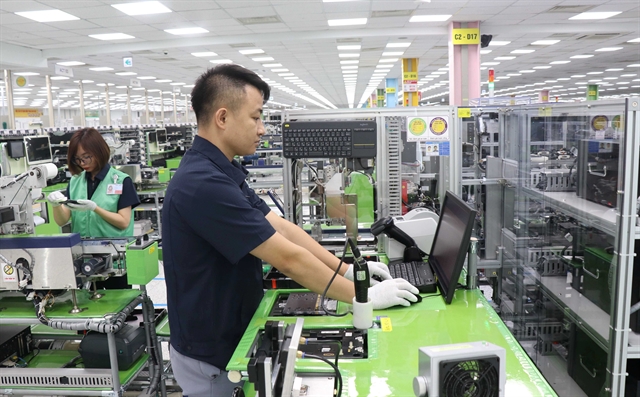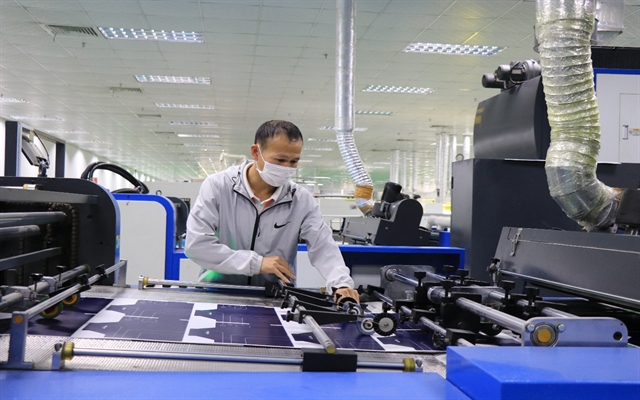 Economy
Economy

 |
| A factory of Vietnam YUTO Printing Packing Co in the northern province of Bắc Ninh. — Photo baotintuc.vn |
HÀ NỘI — Việt Nam’s index of industrial production (IIP) surged 8.6 per cent year-on-year in the first nine months of this year, extending the sector's recovery, the General Statistics Office (GSO) has announced in its monthly report.
In the third quarter alone, the IIP grew nearly 9.6 per cent, marking an upward trend from 8.78 per cent in the second quarter and 6.47 per cent in the first quarter, the GSO noted in the report.
The nine-month IIP growth was driven by the manufacturing sector (up 9.8 per cent), electricity production and distribution (up 11.1 per cent) and water supply and waste-wastewater treatment (up 9.9 per cent). Meanwhile, the mining sector fell 6.4 per cent.
Some key industries with strong growth over this period included steel, up 27 per cent; oil and gas (20 per cent); fabrics (16 per cent); NPK fertiliser (13 per cent) and car manufacturing (12 per cent).
In contrast, several other products witnessed an IIP fall year-on-year such as crude oil, down 16.5 per cent; liquefied petroleum gas (15 per cent); mobile phones (8 per cent) and coal (4 per cent), the GSO stated.
Among 63 centrally-run cities and provinces nationwide, 60 experienced a growth in IIP over the past nine months, while the remainder reported an IIP reduction.
The GSO noted that the number of workers in industrial enterprises as of September 1 increased by 1.1 per cent month-on-month and by 5.2 per cent year-on-year.
In particular, the number of workers in the State-owned enterprise sector remained unchanged compared to the same time last month and rose by 1 per cent year-on-year.
The number of workers in non-state enterprises also increased by 0.9 per cent on-month and 1 per cent on-year, while the number in foreign-invested enterprises increased by 1.3 per cent on-month and 7 per cent on-year.
As of September 30, the inventory index for the processing and manufacturing industry was estimated to increase 5.2 per cent compared to the previous month and 8.5 per cent compared to the same period last year.
The GSO recommended the Ministry of Industry and Trade continue promoting the transition of the industrial sector towards increased contributions to the manufacturing-processing industry and reduce the proportion of machining and assembling of industrial products manufactured in Việt Nam, while removing difficulties for businesses and building technical barriers for imported products.
HCM City’s industrial production up 7%
Following the overall growth of the country's industrial production, the southern economic hub of HCM City saw a 7 per cent increase in its IIP in the nine months, the municipal Department of Industry and Trade has reported.
Industrial production activities in the city continued to recover positively during the period. This shows that the city's stimulus programmes and the connection of domestic and international supply chains have generated excellent outcomes.
In September alone, the IIP rose 3.4 per cent against August and 11.2 per cent from the same period last year.
Industrial production is identified as one of the pillars that affect the city's overall economic growth and have proven the effectiveness of the city's stimulus programmes. The city said it would continue to focus on promoting the development of key industries, including supporting industries and precision mechanics.
Vice Chairman of the municipal People's Committee Võ Văn Hoan said it was necessary to continue implementing demand stimulus programmes and connecting domestic and international supply chains, since the localisation rate, despite remarkable results, still hasn't developed as expected.
The increasing demand of multinational corporations for domestic supply sources requires local authorities, industry associations and enterprises to make further efforts to create breakthroughs, especially in areas requiring hi-tech solutions such as aviation, electronics and automobiles. — VNS




